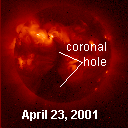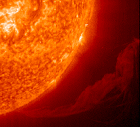|   SPACE WEATHER SPACE WEATHER
Current
Conditions
Solar Wind
velocity: 446.4 km/s
density:2.7 protons/cm3
explanation | more data
Updated: Today at 2248 UT
X-ray Solar Flares
6-hr max: M1 1810 UT Apr24
24-hr: M2 0700 UT Apr24
explanation | more data
Updated: Today at 2250 UT
Daily Sun: 23 Apr '01 
The returning sunspot 9393 (also known as 9433) has a twisted delta magnetic field that likely harbors energy for strong M-class or even X-class solar flares.
Sunspot Number: 140
More about sunspots
Updated: 23 Apr 2001
Radio Meteor Rate
24 hr max: 33 per hr
Listen to the Meteor Radar!
Updated: 24 Apr 2001 Interplanetary Mag. Field
Btotal: 8.3 nT
Bz: 0.7 nT south
explanation | more data
Updated: Today at 2248 UT Coronal Holes:

A coronal hole stretching northward from the Sun's south pole is sending a solar wind stream toward Earth that could arrive by mid-week. Image credit: Yohkoh Soft X-ray Telescope.
More about coronal holes
 SPACE WEATHER SPACE WEATHER
NOAA
Forecasts
Solar Flares: Probabilities for a medium-sized (M-class) or a major (X-class) solar flare during the next 24/48 hours are tabulated below.
Updated at 2001 Apr 24 2200 UT
| FLARE | 24 hr | 48 hr | | CLASS M | 80 % | 80 % | | CLASS X | 25 % | 25 % |
Geomagnetic Storms: Probabilities for significant disturbances in Earth's magnetic field are given for three activity levels: active, minor storm, severe storm
Updated at 2001 Apr 24 2200 UT Mid-latitudes | 24 hr | 48 hr | | ACTIVE | 10 % | 10 % | | MINOR | 05 % | 05 % | | SEVERE | 01 % | 01 % |
High latitudes | 24 hr | 48 hr | | ACTIVE | 15 % | 20 % | | MINOR | 10 % | 10 % | | SEVERE | 05 % | 05 % |

Web server provided by
VPS Hosting
| What's Up in Space -- 24 Apr 2001
Subscribe to Space Weather News!  SOLAR LOOP: Late Monday, the Solar and Heliospheric Observatory spotted an enormous prominence just before it collapsed over the Sun's southwestern limb. The event hurled a bright coronal mass ejection (CME) into space -- but not toward Earth. Click here to view a 400 kb animation of the CME. In the movie, the star-like object moving away from the Sun's southeast limb is the planet Mercury. SOLAR LOOP: Late Monday, the Solar and Heliospheric Observatory spotted an enormous prominence just before it collapsed over the Sun's southwestern limb. The event hurled a bright coronal mass ejection (CME) into space -- but not toward Earth. Click here to view a 400 kb animation of the CME. In the movie, the star-like object moving away from the Sun's southeast limb is the planet Mercury.
GROWING FLARE THREAT: Active region 9393 (aka 9433) continues to grow and now covers an area equivalent to nearly six planet Earths. The big spot has a twisted beta-gamma-delta magnetic field that likely harbors energy for X-class solar flares. Three weeks ago sunspot 9393 unleashed the most powerful solar flare ever recorded. That's unlikely to happen a second time, but the active region nevertheless bears watching. AURORA PHOTOS: As night fell across North America last Tuesday an interplanetary shock wave swept past Earth and triggered a strong G3-category geomagnetic storm. Sky watchers across Canada and in many US states (as far south as California) spotted bright Northern Lights. If you missed the storm, don't worry, you can still visit our April 18th Aurora Gallery. WEB LINKS: NOAA FORECAST | GLOSSARY | SPACE WEATHER TUTORIAL | LESSON PLANS | BECOME A SUBSCRIBER |  
Potentially Hazardous Asteroids (PHAs) are space rocks larger than approximately 100m that can come closer to Earth than 0.05 AU. None of the known PHAs are on a collision course with our planet, although astronomers are finding new ones all the time. [more]
On 24 Apr 2001 there were 307 known Potentially
Hazardous Asteroids April 2001 Earth-asteroid encounters | Object | Date (UTC) | Miss Distance | | 2001 GT2 | 2001-Apr-01 00:09 | 0.0454 AU | | 2001 HB | 2001-Apr-02 04:21 | 0.0323 AU | | 2001 FA58 | 2001-Apr-02 07:56 | 0.1128 AU | | 1986 PA | 2001-Apr-03 01:06 | 0.1465 AU | | 2000 EE104 | 2001-Apr-12 20:37 | 0.0822 AU | | 2001 GR2 | 2001-Apr-18 04:07 | 0.0761 AU | | 2001 GQ2 | 2001-Apr-27 12:00 | 0.0199 AU | 
- TOTAL LUNAR ECLIPSE: On Jan. 9, 2001, the full Moon glided through Earth's copper-colored shadow. [gallery]
- CHRISTMAS ECLIPSE: Sky watchers across North America enjoyed a partial solar eclipse on Christmas Day 2000 [gallery]
- LEONIDS 2000: Observers around the globe enjoyed three predicted episodes of shooting stars. [gallery]
 Feb. 21, 2001: Nature's Tiniest Space Junk -- Using an experimental radar at the Marshall Space Flight Center, scientists are monitoring tiny but hazardous meteoroids that swarm around our planet. Feb. 15, 2001: The Sun Does a Flip -- NASA scientists who monitor the Sun say our star's enormous magnetic field is reversing -- a sure sign that solar maximum is here. Jan. 25, 2001: Earth's Invisible Magnetic Tail -- NASA's IMAGE spacecraft, the first to enjoy a global view of the magnetosphere, spotted a curious plasma tail pointing from Earth toward the Sun. Jan. 4, 2001: Earth at Perihelion -- On January 4, 2001, our planet made its annual closest approach to the Sun. Dec. 29, 2000: Millennium Meteors -- North Americans will have a front-row seat for a brief but powerful meteor shower on January 3, 2001. Dec. 28, 2000: Galileo Looks for Auroras on Ganymede -- NASA's durable Galileo spacecraft flew above the solar system's largest moon this morning in search of extraterrestrial "Northern Lights" Dec. 22, 2000: Watching the Angry Sun -- Solar physicists are enjoying their best-ever look at a Solar Maximum thanks to NOAA and NASA satellites. MORE SPACE WEATHER HEADLINES |

